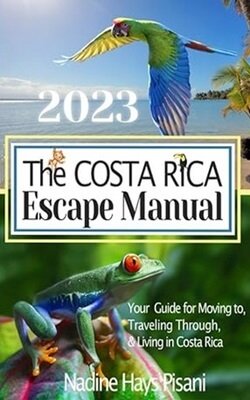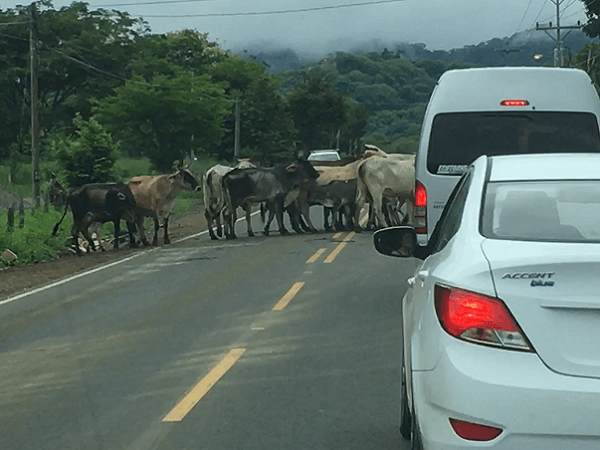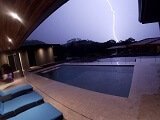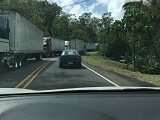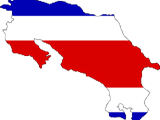- Home
- Visiting Costa Rica
- Driving
Search this site
Driving in Costa Rica
Driving in Costa Rica can be as easy or as hard as you make it. Stay on the main paved roads in the daytime and avoid driving during storms (easier said than done sometimes) and you will most likely be fine. Venture onto the dirt roads and nothing is guaranteed.
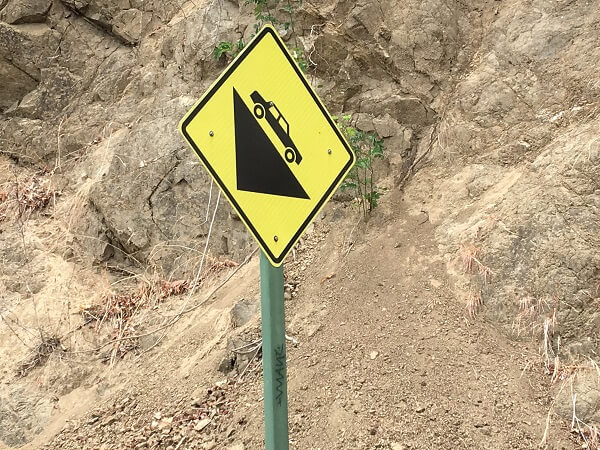
I have driven about 35,000 miles in Costa Rica (40,000 km) with the majority being on paved roads in San Jose and its surrounding suburbs, the Central Valley, Pacific Coast and up to the Nicaragua border. However, some of that has been on 20-30 mile long dirt roads which is an entirely different experience.
Weather, darkness, animals, potholes and downed trees are the most significant factors that can turn even a good paved road into trouble. Add in a dirt road to all of the above, and it can get bad very fast.
There are also unique laws and rules that you need to be aware of, otherwise you could face serious consequences while driving in Costa Rica.
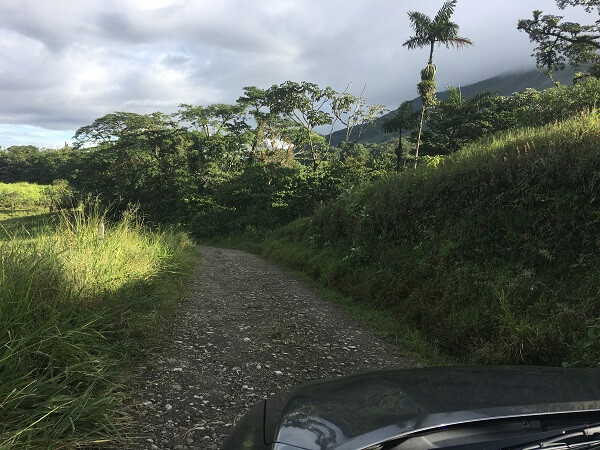
Who is Legal to Drive
You must have a valid foreign or Costa Rica driver's license to be able to drive in Costa Rica. You also must be at least 18 year of age to drive here.
The information below is complicated, and will probably leave you scratching your head wondering why, but it is the current law.
If you are a visitor, or have moved here without obtaining legal residency, then your foreign driver's license is valid for up to 90 days unless the Immigration Agent has written a lesser number on your visa stamp in your passport. Recent changes to immigration law changed the number of days that your visitor's visa is good for from 90 to 180. However, as of February 2024, the maximum number of days that a foreign drivers license is valid remains at a maximum of 90 days. It is anticipated that Costa Rica will sync up the visa and drivers license number of days to be the same (180) in the near future. Before your reach the allowed number of days, you must leave the country, or leave and re-enter. In doing this you will receive a new visa stamp and the process starts over.
If you have applied for Temporary residency, and your application has been accepted for processing, you do not need to leave the country to keep you immigration status legal, but you must leave, as controlled by the number of days on your passport stamp, to keep your foreign driver's license valid.
In summary, look at your Passport visa stamp and determine the number of days that was written in. This is the number of days from your date of entry that you foreign driver's license is valid for, not to exceed a total of 90 days.
When you obtain full legal temporary residency, by receiving your Cedula ID card, and your foreign driver's license is no longer valid, you can go obtain a Costa Rica license. Yes, you read that correct, on the first day that your foreign driver's license becomes invalid, you can go get your Costa Rica license.....somehow. This is because Costa Rican law says that you cannot be in possession of two valid drivers licenses at the same time.
It is also important to keep track of the expiration date of your driver's license from the issuing country. While you may be within the specified time limit in Costa Rica, if it has expired in the issuing country, your license will be considered invalid.
Important! - If you have a Costa Rica car insurance policy, or are renting a car that includes insurance, and your drivers license is considered expired, then your insurance is also invalid.
Police
Police checkpoints are common. I have been through about a dozen in the last year. They can be anywhere and for any reason. Police don't require a reason to stop you in Costa Rica. Some checkpoints are casual with an officer or two and others are somewhat intimidating with a dozen or so officers, some with automatic weapons.
Checkpoints are random but they do have some favorite places. In Guanacaste where the weather can be very hot, especially in the afternoon, checkpoints are more likely to be in the morning under a shady stretch of road. In high tourists seasons, such as Christmas and Easter, the number of checkpoints increases significantly.
One day I went through three checkpoints in just a few miles. It was funny because I don't think the police at one checkpoint knew that there were police at a checkpoint just a few hundreds yard back and over a slight rise in the road where they couldn't see each other.
If you don't have legal residency, you must show proof to the police of a valid driver's license and your passport. We were told to always have a copy of our passport in the car. Copies were accepted several times without issues but we have a few friends where a copy didn't work and they received a ticket. Take your Passport everywhere, but protect it.
Police sometimes drive with their overhead red and blue lights on all the time. While it can be intimidating if they pull up behind you, unless they signal you to pull over or turn on their siren, just continue driving as normal.
There are few radar traps, but they do exist. Usually they are on long roads in the middle of the country with nothing around. The Transit Police (think highway patrol - dark blue SUVs with yellow markings), usually coordinate them. Unlike the United States and Canada where the radar is mounted inside or on the car and they pull out behind after you pass, in Costa Rica they setup a tripod that one officer watches over it while the other steps out into the middle of the road to pull you over as you approach.
In general, offering bribes are frowned upon and I wouldn't recommend doing it. However, as is all countries, there will be a few officers that will imply that they want one in order to let you go.
Police are generally polite and embrace the Pura Vida lifestyle. I have not seen any signs of major corruption other than the "septic" system scam. This has happened to us and our friends several times and is widespread especially in Guanacaste. A large group of officers set up a road block, selectively pull people over (mostly tourists). One officer approaches your car and has his phone that contains a translated message into English asking for a donation to help them fix the police office's septic system. This can be quite intimidating to the first time visitor or someone that has not lived here long. The first time we gave them a little money. The next two times we just said "not today, no thank you" and we were fine and allowed to proceed. A few times after that I think they started to recognize us and didn't pull us over. It was always the same group of police officers. Pura Vida.
Tickets
Get a ticket while driving in Costa Rica and the police unbolt and take the license plates from your car. You can drive the car home, but that's it, no more driving that vehicle until you pay your fine in person and retrieve your plates. Plain, simple and very effective for making sure you show up to pay.
Accidents
All vehicles, involved in an accident, no matter how minor, must leave the vehicles in the position of the accident. The Transit Police (blue vehicle with yellow letters) will come, evaluate and determine who is at fault on the spot. Do not move your vehicle until the Police show up and direct you to do so.
If you have an accident while driving in Costa Rica under a foreign driver's license that results in the injury of another party, and you were at fault, there is a good chance that your passport will be revoked and you will not be able to leave the country until the issue is resolved. Resolution of the issue usually means a financial payout to the person and/or family that was injured. This could take weeks, months or even years.
Navigation
Unless you are in, or around San Jose, physical addresses do not exist. Googlemaps and Waze are the best ways to navigate when driving in Costa Rica, with Googlemaps being preferred.
While Waze works fine, every time you turn your phone on to navigate, Waze has to download the maps and continuously update traffic data. This may be great if you start out in an area with sufficient coverage, but it you have to start navigating from an area with poor cell service, or your phone locks up, requiring a restart, you could be without navigation.
Googlemaps allow you to download and store maps to your phone and therefore you don't need any cell service at all to navigate. In fact, you can actually turn off cell service with have GPS active and you will be fine.
If you are going to navigate using your phone with cellular data turned on, make sure that you have a cell phone service that has unlimited data for Costa Rica. Before we got our Costa Rica phone number, we had T-Mobile and did not incur any additional data or text charges. It worked flawlessly and provided great service even when in somewhat remote areas.
Learn more about the advantages and disadvantages of both Goolemaps and Waze in Costa Rica.
Four Wheel or All Wheel Drive is a Must
You are ready to arrive and your itinerary has you driving in Costa Rica on the main, paved roads. To save a few dollars, you opt for the small 2WD compact. I did this once and it was the last time.
My trip had me driving from San Jose to Playa Flamingo, a distance of about 160 miles. On a normal day this trip takes about 4 hours and all of the roads are in excellent condition. What could go wrong ?
Just south of the turn off to Monteverde, I came across a police office with his car blocking the lanes ahead. He rapid fired a bunch of words in Spanish and I tell him that I only speak a little bit of Spanish (I know much more now). He then says, in perfect English, "ok, here is the deal. A truck has hit the bridge ahead and we don't know if it is safe or not. Until we figure it out you will need to turn right here and drive for about 20km. Then take a left followed by another left and you will come out on the other side of the bridge and be good to go". Great, this translated into driving about 50km ( a little over 30 miles ) and ending up just up the road from where I currently was. It was mid afternoon and sunset was approaching. I didn't want to drive unfamiliar roads in the dark in a country that I was not familiar with, so I went for it.
Although inconvenient, it sounded easy, and I am sure my little Toyota 2WD compact would be just fine. With my Googlemaps running on my cell phone in GPS mode I felt pretty confident. The first leg lasted forever, but it was all paved and in good condition. It was a pretty drive and is one of the ways that you get to cloud forest of Monteverde. I was climbing in altitude and I finally reached the intersection where I made my first left. Guess what ? Dirt road filled with rocks, potholes and ruts. My little Toyota spends the next hour plus slowly easing its way over and around all of the obstacles. Fortunately for me it was dry season and there were no signs of recent rains. If this had been green season, I would have never made it. I finally made it back to the main road only to look to the left and see where I was originally.
Moral of the story. Always a 4WD or AWD. When driving in Costa Rica, always expect the unexpected.
Two Lane Roads are the Rule
Unlike where I moved from in San Diego, where freeways were sometimes up to 12 lanes wide each way, most roads in Costa Rica are two lanes and not divided. There are exceptions such as Highway 1, the Pan American highway, that has a small portion that is divided with two lanes each way. There are some roads around San Jose that are 3 and 4 lanes wide at points such as highway 27. There are also some roads over the mountains that will have additional passing lanes, but in general, you are stuck with two lanes.
It is very common that bridges over small streams and rivers will be only a single lane. This usually isn't an issue and simply requires patience and good timing. Although some are only wide enough for one car at a time. Usually they are well marked, but not always.
Passing another vehicle is a skill that you need in Costa Rica.....and you need to be good at it. Not all drivers here are good at it and will often pass on blind corners or with oncoming traffic straight ahead. You always need to pay attention to the road, and not at the stunning scenery and beauty of this amazing country.
It Takes Forever to go Almost Anywhere
In general, no matter where you travel, the average speed of driving in Costa Rica will be 35-40 mph. This turns from, what is the United States is a two hour trip, into a 3-4 hour trip. You will have periods where you can travel faster, but this is more than offset by road maintenance/closures, slow moving vehicles, animals, weather, fallen trees and police checkpoints.
Slow moving vehicles and trucks, even on flat straight roads, will often line cars up behind for a long way. Add in the curvy and inclined roads in the hills and mountains can have you going 5 mph for what seems like days.
You may think that the town or place you want to go is only a few miles away only to find out that you have to make a big loop to get there, often having to double back in the other direction.
Accidents that block the lanes will take hours to clear. Because Costa Rica law states that the vehicles in an accident must remain in place until police clear the scene, you can end up waiting for hours if the road is blocked. We waited two hours one night and were just a few hundred yards away from where we live.
Watch out for these when driving in Costa Rica
Speed bumps can appear out of nowhere. Some are marked in yellow, others not marked at all. Sometimes there will be signs such as "reductor velocidad", (speed reducer) but don't depend on it. Almost every small town or neighborhood has at least two speed bumps, one when entering and one when exiting but there may be more. School zones often have speed bumps but not always.
Cars will stop suddenly in the middle of a lane for what seems like no reason, only to find out they are picking someone up or having a conversation. They rarely pull off to the shoulder, if a shoulder even exists.
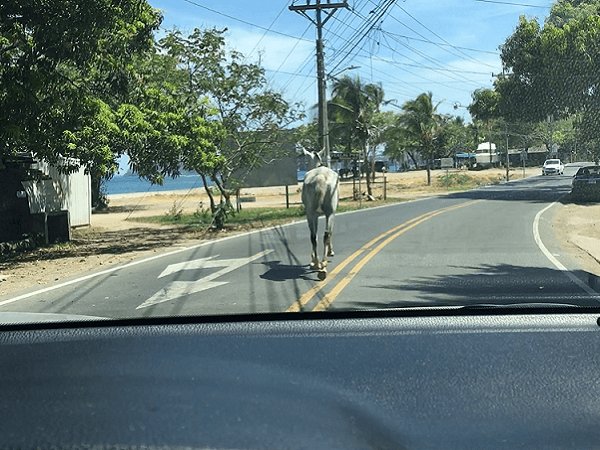
Horses, goats, cattle and large iguanas in the road are very common and one must always be on alert. You may go around a corner and have little time to react.
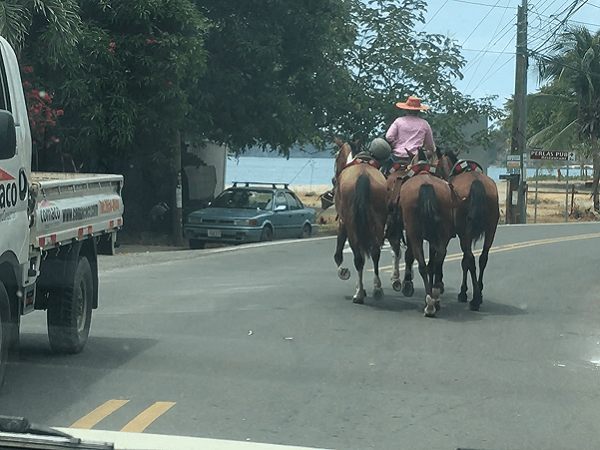
This country has the legacy of being the pothole capital of the world. After driving in Costa Rica for a few years, I think this is way over exaggerated, but they still deserve respect and a constant eye looking out for them because they can be large enough to cause serious damage. What was a perfect road the day or week before, can be impacted significantly by weather in a heartbeat. Don't assume a puddle is only a few inches full of water, it could be a few feet.
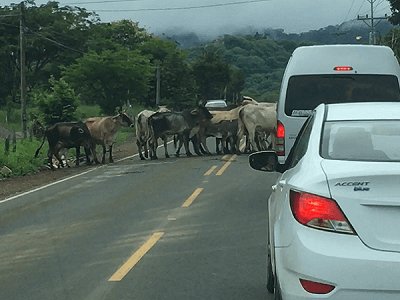
The extreme weather in Costa Rica can change a good road into one with no visibility in just a few minutes, even in the daytime.
Night time driving in Costa Rica can be a challenge. Bicyclist with no lights and wearing dark clothing are common. There will be the occasional vehicle with no tail lights and sometimes no headlights too. Potholes will be invisible, especially during night time rain, and some of them are large enough to blow a tire out or damage your car. Add in heavy rain or dense fog, it gets scary really fast.
Protests - When the Costa Rican government makes changes to the law or proposes to raise taxes, many people head to the streets and set up blockades on major roads throughout the country. It is a very coordinated and effective effort but also very frustrating if you get stuck in one. If this happens, it is not uncommon to be stopped at a single road block for 6-8 hours, if not more, with no alternative route or exit. Plus if you are traveling a long distance, you will most likely run into several. In general, but not always, protests are not violent. Sometimes they end turning into more of a social event with people setting up barbeques, playing music and chatting with each other. Keep on eye on the local news as there are usually warnings about scheduled protests. However, sometimes they just happen without warning.
Know How to Change a Tire
In 50 years of driving in the United States, I never had a flat tire on the road. In the first year of living and driving in Costa Rica, I had 6 flat tires. In fact, I get them so often that before I get into my car, I walk around and check all four tires and now carry a portable air compressor.
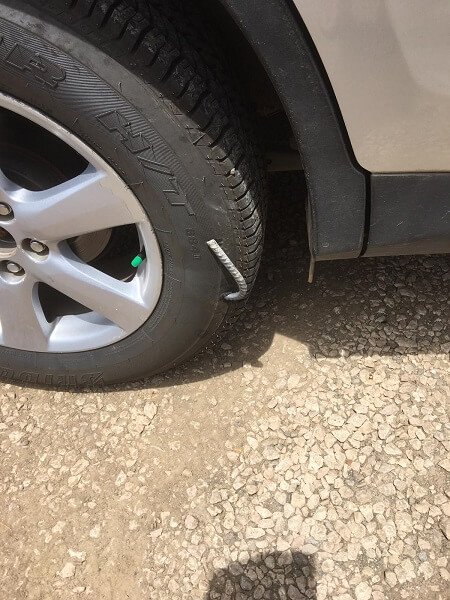 Flat Tire Costa Rica Style
Flat Tire Costa Rica StyleThe last flat was just after we stopped at a nursery and picked up 90 small plants and put them in the back of the SUV. Then we stopped and got groceries. Came out to the car to go home and the tire was flat. Everything had to be unloaded into the Maxi-Pali parking lot on a very hot and humid 95 degree day. No fun.
Potholes, sharp rocks, nails, screws, wood and other road debris are common. Some of the rocks, at least in the Guanacaste province, are like knives.
Make sure your spare is in good condition and full of air. Know where your jack is and how to use it. Always carry a 2-3 foot pipe that can be used as an extension to the lug wrench to remove the lug nuts that were installed too tightly by the last person who put the tire on.
While there is roadside assistance, there is no AAA to call and waits could be lengthy.
Purchase a small portable AC/DC air compressor and keep it in your car at all times. Having one may at least get you to the nearest tire repair place, or perhaps all the way home.
Safety Equipment
If you break down on the road, there is a very good chance that you will be stuck in the middle of a traffic lane. Road shoulders are few and far between and those that look like a shoulder, may be filled with mud, holes or rocks.
It is highly recommended that you carry the following:
- Jumper cables
- Power Pack that can jump a battery without jumper cables
- Portable air compressor
- Flashlight w extra/batteries
- 2-3 Reflective stand up triangles or pop-up cones
- Reflective vest to wear
- Heavy duty tow rope or ratchet straps
- Extra water. Breaking down in the heat and humidity in the middle of nowhere can be life threatening
Don't Drive on the Beach
The tides in Costa Rica are extreme. They can swing between 9 and 10 vertical feet during certain times of the month. The water rises quickly.
Drive down on low tide and get stuck in the sand or have car problems, your car is probably floating away unless immediate help is nearby. In Costa Rica, immediate help is rarely close by. Best advice is don't do it.
In Summary
This may be hard to believe, but I have I found that the paved roads in Costa Rica have been much better than many roads in San Diego, CA. When road issues arise, work crews have been quick to fix.
Except for the flat tires, driving in Costa Rica has been much better than I expected, however, it still requires a great deal of caution and respect.
